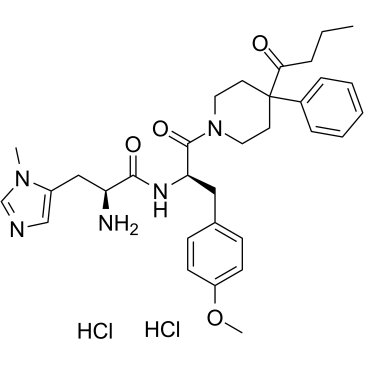BMS 470539 dihydrochloride
Modify Date: 2025-08-27 17:45:01

BMS 470539 dihydrochloride structure
|
Common Name | BMS 470539 dihydrochloride | ||
|---|---|---|---|---|
| CAS Number | 2341796-82-3 | Molecular Weight | 632.62 | |
| Density | N/A | Boiling Point | N/A | |
| Molecular Formula | C32H43Cl2N5O4 | Melting Point | N/A | |
| MSDS | N/A | Flash Point | N/A | |
Use of BMS 470539 dihydrochlorideBMS-470539 dihydrochloride is a highly potent and selective melanocortin-1 receptor (MC-1R) agonist with an IC50 of 120 nM, an EC50 of 28 nM. BMS-470539 dihydrochloride does not activate MC-3R and is a very weak partial agonist at MC-4R and MC-5R. BMS-470539 dihydrochloride has potently anti-inflammatory properties[1][2][3]. |
| Name | BMS-470539 dihydrochloride |
|---|
| Description | BMS-470539 dihydrochloride is a highly potent and selective melanocortin-1 receptor (MC-1R) agonist with an IC50 of 120 nM, an EC50 of 28 nM. BMS-470539 dihydrochloride does not activate MC-3R and is a very weak partial agonist at MC-4R and MC-5R. BMS-470539 dihydrochloride has potently anti-inflammatory properties[1][2][3]. |
|---|---|
| Related Catalog | |
| Target |
IC50: 120 nM (Melanocortin-1 receptor); EC50: 28 nM (Melanocortin-1 receptor)[1] |
| In Vitro | An HBL melanoma cell line is established that stably expresses a NF-κB luciferase reporter. In these cells, 0.5 ng/mL TNF-α induces a dose-dependent increase in NF-κB luciferase activity. Treatment of HBL-NF-κB cells with BMS-470539 elicits a dose-dependent, statistically significant reduction in TNF-α-stimulated NF-κB luciferase activity. BMS-470539 has no effect on luciferase reporter activity in the absence of TNF-α stimulation. In nontransfected HBL cells, treatment with BMS-470539 results in a dose-dependent inhibition of NF-B nuclear translocation[2]. |
| In Vivo | BMS-470539 (2.05-18.47 mg/kg; intravenous injection; for 125 minutes; WT and MC1 receptor recessive e/e mice) treatment inhibits cell adhesion and emigration with no effect on cell rolling. And also inhibits the tissue expression of both CXCL1 and CCL2[3]. Animal Model: Wild-type (WT) and MC1 receptor recessive e/e mice induced with ischaemia-reperfusion[3] Dosage: 2.05 mg/kg, 6.16 mg/kg and 18.47 mg/kg Administration: Intravenous injection; for 125 minutes Result: Inhibited cell adhesion and emigration with no effect on cell rolling. Inhibited tissue expression of both CXCL1 and CCL2. |
| References |
| Molecular Formula | C32H43Cl2N5O4 |
|---|---|
| Molecular Weight | 632.62 |
| InChIKey | DUAOBJHRUKFKIH-YDVFRNEYSA-N |
| SMILES | CCCC(=O)C1(c2ccccc2)CCN(C(=O)C(Cc2ccc(OC)cc2)NC(=O)C(N)Cc2cncn2C)CC1.Cl.Cl |